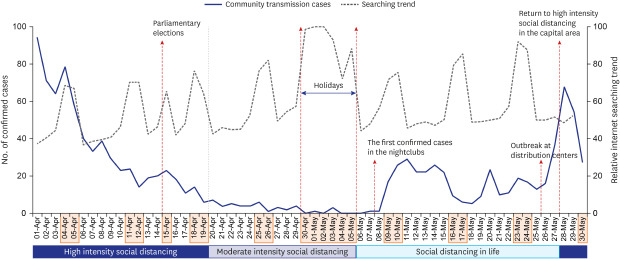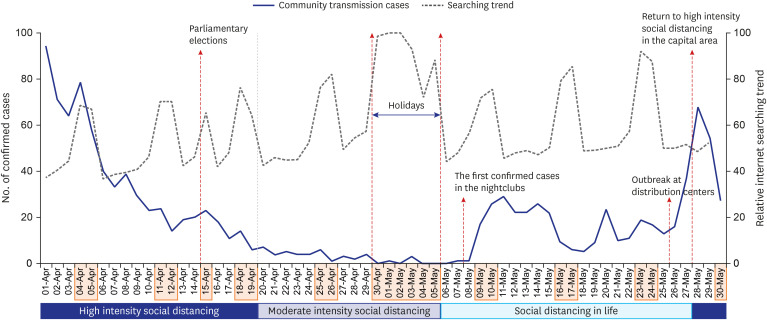Graphical Abstract

Epidemiological investigation-based quarantine, massive screening, and social distancing were the three main pillars to successfully control the first wave of coronavirus disease 2019 (COVID-19) epidemic in Korea. Similarly in China, the effective reproduction number of severe acute respiratory syndrome coronavirus 2 decreased from 3.82 on January 24, 2020, to < 0.3 on March 1, 2020, after the implementation of public health interventions.1 With the successful social distancing measure, new occurrences of COVID-19 have decreased to < 10 cases/day in Korea since April 19, 2020 (Fig. 1).2 The parliamentary election was safely conducted on April 15, while social distancing was consistently maintained, and the number of new occurrences of COVID-19 continued to decrease thereafter.
Fig. 1. Timeline of the coronavirus disease epidemic in Korea and correlation between the social distancing strategy and the Internet search trend for leisure activities. Relative internet searching trend is an indicator of relative change in searching interest in a given period of time by setting the maximum level of interest at 100.
The Korean government established an exit strategy to ease social distancing on the basis of the premise that < 50 local community-acquired infections occur per day and that among these, < 5% have unknown infection routes.2 Thus, the government periodically assessed the COVID-19 epidemic level and gradually eased the intensities of social distancing from high (until April 18) to moderate (April 19‒29) and social distancing in life (since April 30). While maintaining strict quarantine, massive screening, and isolation, the government attempted to revitalize the economy with mitigated social distancing. However, many confirmed cases were identified during this policy transition. At the end of the moderate-intensity social distancing, people's interests in leisure (taking trips, eating at restaurants, visiting bars, and lodging) increased markedly according to the Internet search trend (Fig. 1).3 The internet search trend is to check the daily number of searches for the specific search terms and set the maximum search volume to 100 during the search period to calculate the relative change of the day, using the analysis program, NAVER (NAVER Corp., Seoul, Korea). After the serial interval (7‒8 days) from the mitigating transition, the number of confirmed cases again began to increase, particularly in young adults.4 These cases, which could represent a second wave in Korea, have spread around nightclubs in Itaewon, a frequent foreign tourist destination. They have spread rapidly to the families and coworkers, given the socially active nature of young people, thereby spreading to other regions. The resurgence, which started at nightclubs, is feared to progress to a larger outbreak, as it has ignited in distribution centers.2
Some prerequisites to implementing a mitigation strategy successfully are as follows. Special groups that can be a vulnerable point of infection in the community must be considered. In Korea, such foci were mass-gathering churches, call centers, distribution centers, indoor sports facilities and nightclubs.2,5 A second wave could start with delayed detection and reporting of these social vulnerabilities. When mitigating social distancing measures, a management plan for vulnerable facilities and locations should be reinforced. It is necessary to guide and support to keep the standards such as strengthened mask wearing, maintaining individual distancing, improving ventilation facilities, and limiting the number of attendees. In addition, it is even more important to monitor whether these principles are being met and provide feedback.
Footnotes
Disclosure: The authors have no potential conflicts of interest to disclose.
- Conceptualization: Jung J, Song JY.
- Writing - original draft: Jung J, Song JY.
- Writing - review & editing: Jung J, Noh JY, Cheong HJ, Kim WJ, Song JY.
References
- 1.Pan A, Liu L, Wang C, Guo H, Hao X, Wang Q, et al. Association of public health interventions with the epidemiology of the COVID-19 outbreak in Wuhan, China. JAMA. 2020;323(19):1–9. doi: 10.1001/jama.2020.6130. [DOI] [PMC free article] [PubMed] [Google Scholar]
- 2.Korea Ministry of Health and Welfare, Korea Center for Disease Control and Prevention. Updates on coronavirus disease 2019 (COVID-19): for press release. [Updated 2020]. [Accessed May 30, 2020]. https://www.cdc.go.kr/board/board.es?mid=a20501000000&bid=0015.
- 3.Naver. Naver DataLab - keyword trend analysis. [Updated 2020]. [Accessed May 30, 2020]. https://datalab.naver.com/keyword/trendSearch.naver.
- 4.Li Q, Guan X, Wu P, Wang X, Zhou L, Tong Y, et al. Early transmission dynamics in Wuhan, China, of novel coronavirus-infected pneumonia. N Engl J Med. 2020;382(13):1199–1207. doi: 10.1056/NEJMoa2001316. [DOI] [PMC free article] [PubMed] [Google Scholar]
- 5.Park SY, Kim YM, Yi S, Lee S, Na BJ, Kim CB, et al. Coronavirus disease outbreak in call center, South Korea. Emerg Infect Dis. 2020 doi: 10.3201/eid2608.201274. Forthcoming. [DOI] [PMC free article] [PubMed] [Google Scholar]



